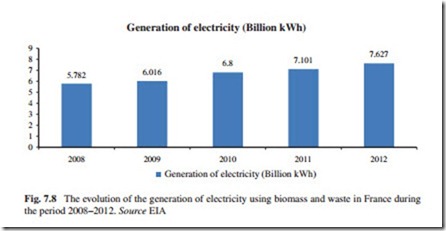France
France has adopted a national target for the share of renewable energy sources in gross final consumption of energy in 2020 of 23 %. For this reason, France wants to near-triple the size of its installed generation capacity from biomass, from 1,052 MW in 2010 to 3,007 MW in 2020, of which 2,003 MW or 66.6 % will be for electricity generation. According to French experts, biomass should represent 45 % of the overall renewable energy effort of the country in the coming years. To reach that goal, the government estimates that the total subsidies to be given to the energy industry will reach €170 billion by 2020, with more private finance entering the game in 2011 at the expense of solar energy.
However, it is important to highlight a recurring problem in French silviculture: the fractured nature of woodland and forest. According to government sources, around 40 % of the 15.7 million ha of the French forest remains dormant often split into small grids of forestland of only a few hectares. The result of underuse of the forest land combined with wood demand means that France imports €6.3 bil- lion per year of wood, more than 50 % of which is used for fuel. This situation leaves the exploitation of French forest land costly and impedes the easy supply of biomass facilities.
Other issues include the energy uses of biomass. Although biomass is by far the largest renewable fuel in France, at about 46 % of the country’s total renew- able energy, around 95 % of that use is for heating not for electricity generation. Boosting biomass electricity generation means that stresses will be placed on industrial wood pellet production. Production in France rose from 240,000 tons per year in 2008 to around 465,000 tons per year in 2010. To meet planned generating capacity, pellet production must double again by the end of 2012 to about 1 billion tons per year.
In 2010, a total of 172 wood energy installations have been identified in the country. These facilities consume 38,000 tons of biomass each year: 20,000 tons coming from forest and 13,000 tons of wood recovery. Another 113 new projects are under consideration or in progress. To support this effort, the European Investment Bank (EIB) and French banking groups BPCE and Crédit Agricole have announced they will lend €250 million to biomass-fired energy installations in France. The EIB explained that the funding can be used toward financing bio- mass heat only and CHP installations, as well as facilities producing biogas and electricity from municipal waste.
Finally, it is important to highlight that despite the French economic crisis, the context is still favorable to the development of sustainable energies. First, because of the French and European Directives which are aiming to:
• Reach by 2020 a total of 20 % of sustainable energy in the energetic consumption of the EU-27 member states (excluding Croatia, the latest EU member states);
• Increase by 50 % the renewable heat generation;
• Reduce the VAT on subscription and supply of heat coming from renewable energy.
And second, particularly for biomass, because of the resulting French government measures:
• Rollout of a new call of tender for the development of biomass power plants.
The target is to reach a cumulative power of 1,000 MW with those kind of power plants;
• Rollout for a new call for project by the French Energy Regulatory Commission in order to allow the takeover by the government of the electricity produced by cogeneration facilities that will be able to run with biomass;
• Setting up of a “Heat Fund,” bound to support the building of collective boiler rooms using renewable energies.
The context is favorable to the development of sustainable energies. The biomass resources are available in the developed countries, but the use of biomass remains low, especially in France.
Generation of Electricity Using Biomass and Waste
The evolution of the generation of electricity using biomass and waste in France during the period 2008–2012 is shown in Fig. 7.8.
According to Fig. 7.8, the use of biomass and waste for the generation of electricity in France during the period 2008–2012 increased 31.9 %. It is expected that the use of this type of energy source for generating electricity will intensify during the coming years. However, the lack of regulatory frame for the use of natural resources, especially energy wood, incites the energy companies and the boiler manufacturers to be reluctant to invest in biomass, something that the government should solve as soon as possible in order to reach the goal adopted regarding the participation of biomass and waste in the generation of electricity in the future.
